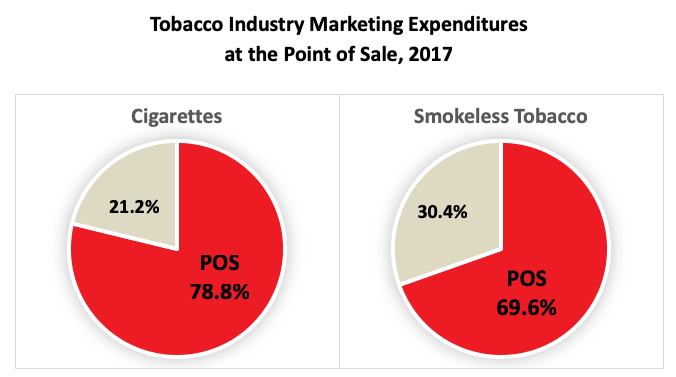In 2017, the tobacco industry spent over $7.3 billion marketing and promoting cigarettes and smokeless tobacco at the point of sale (POS).
These POS expenditures account for over 78% of the tobacco companies’ total marketing dollars spent on cigarettes and smokeless tobacco combined. These figures, recently released in the Federal Trade Commission (FTC) Reports on Cigarettes and Smokeless Tobacco Sales and Marketing Expenditures in 2017, document a continued concentration of tobacco industry expenditures at the POS. The FTC has been preparing reports on sales, advertising, and promotions of cigarettes since 1967 and smokeless tobacco since 1987. Reports are issued periodically and give tobacco control advocates detailed advertising and promotion spending reports in more than two dozen categories. The spending reports show that tobacco companies spend the majority of their marketing dollars on two categories: price discounts and promotional allowances to keep products cheap and visible at the point of sale. See more details here.
When factoring in price discounts and promotional allowances paid to wholesalers, which also ultimately reduce the price of products to consumers, the amount spent rises over 96% of the tobacco industry’s total marketing budget. These price discounts counteract the impact of tobacco control policies like excise taxes and target price sensitive smokers.
- What are Price Discounts? Price discounts are what tobacco companies pay to cigarette retailers or wholesalers in order to reduce the price of cigarettes to consumers, including off-invoice discounts, buy-downs, voluntary price reductions, and trade programs.
- What are Promotional Allowances? Promotional allowances are what tobacco companies pay to either cigarettes retailers or wholesalers in order to facilitate the sale or placement of tobacco products. For retailers, this can include payments for stocking, shelving, displaying and merchandising brands, volume rebates, incentive payments, and the cost of tobacco products given to retailers for free for subsequent sale to consumers. For wholesalers, this can include payments for volume rebates, incentive payments, value added services, promotional execution and satisfaction of reporting requirements.
While the total amount tobacco companies spent on marketing for cigarettes and smokeless tobacco decreased slightly in 2017, the proportion that they spend directly in the retail environment rose by 3%. Price discounts remain the largest category for both cigarettes and smokeless tobacco, increasing by 7% for cigarettes from 2016-2017. While expenditures on coupons for cigarettes dropped, expenditures on coupons for smokeless tobacco increased by 37% from 2016-2017. Combined expenditures on all types of price discounts comprise 85.5% of industry spending on marketing and promotions.
Remember that these numbers are for cigarettes and smokeless tobacco alone – they do not include any marketing expenditures for cigarillos, little cigars, or e-cigarette products. However, future reports may include e-cigarette expenditures – this year the FTC issued a statement noting that, “The FTC lacks similar data about the rapidly growing market for e-cigarettes, and as a result the FTC’s and the public’s understanding of the overall market for nicotine-based products is substantially incomplete. The Commission will endeavor to close this gap in our understanding by collecting data on e-cigarette sales and marketing and sharing that information with the public in a similar report.”
Tobacco marketing at the point of sale matters.Research shows that tobacco marketing can cause youth to start smoking, keep current smokers hooked, and make it harder for current and former users to quit and stay quit. These FTC reports emphasize the critical need to monitor and address tobacco industry activity in the retail environment. Learn more about the FTC reports, The War in the Store, and strategies to limit price discounts, promotions, and POS advertising in your community.
Note: In 2016, the FTC Cigarette and Smokeless Tobacco Reports began separating price discounts into amounts paid to retailers and amounts paid to wholesalers. In previous calculations, we had included this category as a whole. In an effort to keep track of what is directly spent at tobacco retail locations like convenience stores that any person can access, we calculate the amount spent at the POS uses the following categories: (a) point-of-sale advertisements, (b) price discounts to retailers, (c) promotional allowances to retailers, (d) retail-value added bonus tobacco products and bonus non-tobacco products, (e) coupons, and (f) consumer engagement. Other marketing dollars not considered to be aimed at POS include, for example, dollars spent on direct mail, magazines, internet, or sponsorships. However, we also are reporting totals including price discounts and promotional allowances paid to wholesalers for their role in reducing the price of tobacco products for consumers.


